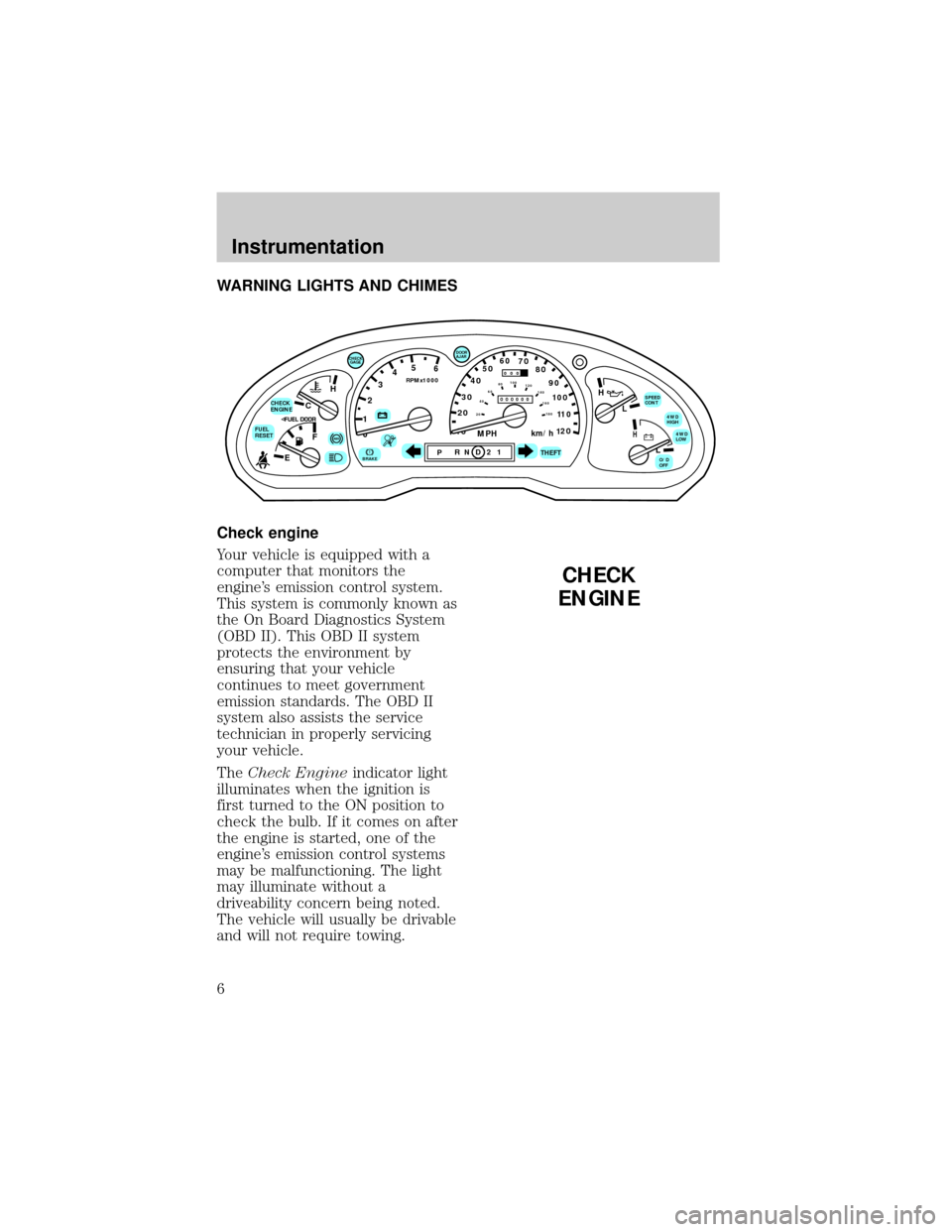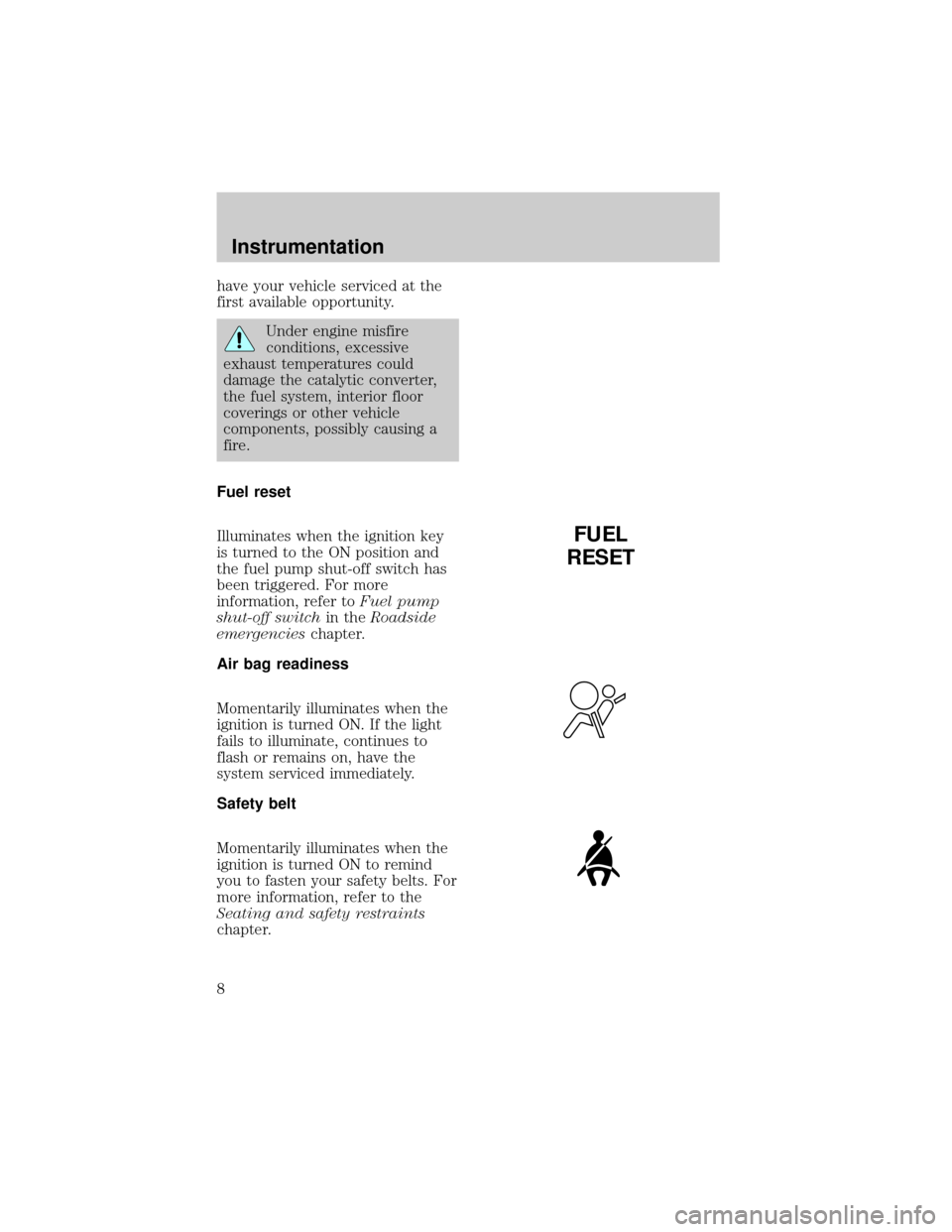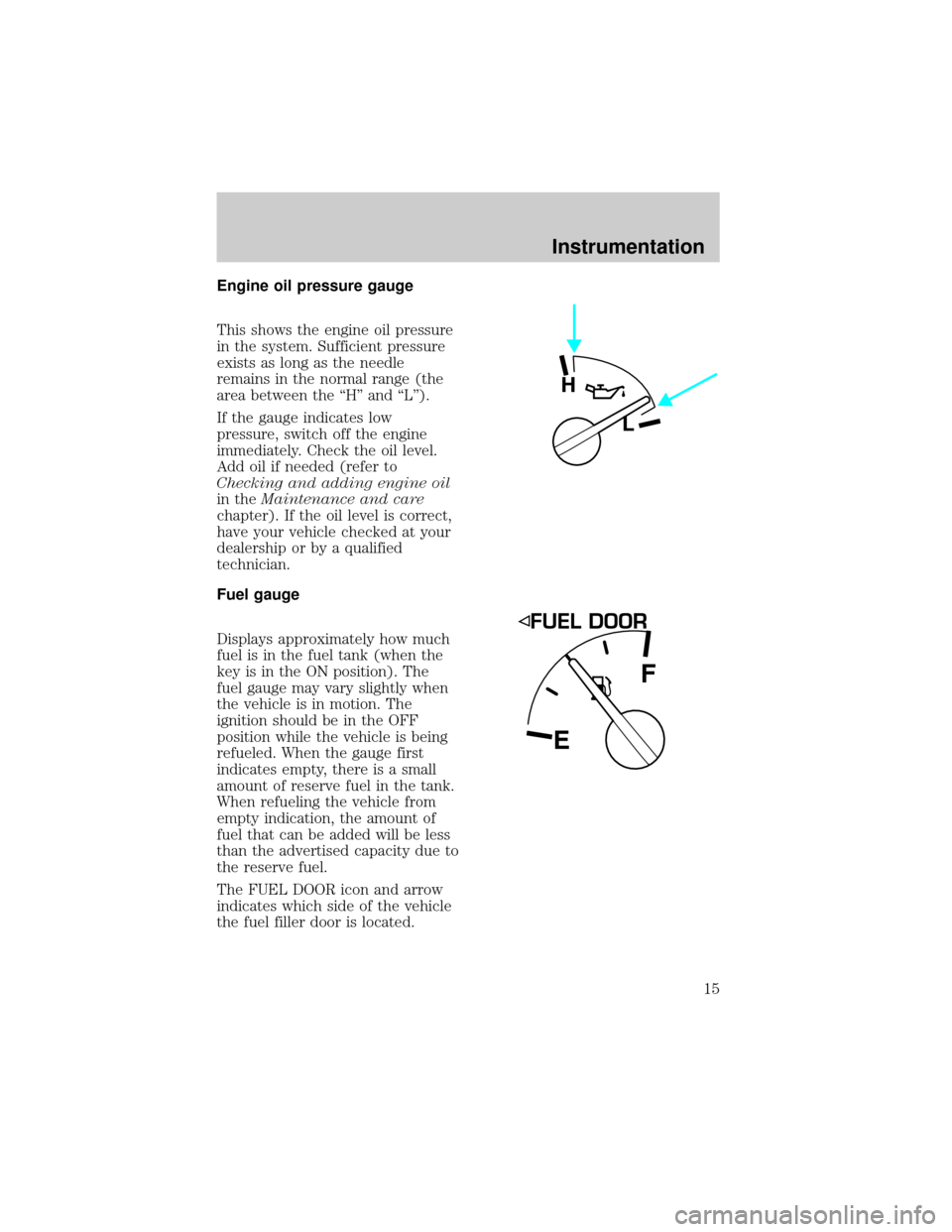Light Mercury Mountaineer 1998 Owner's Manuals
[x] Cancel search | Manufacturer: MERCURY, Model Year: 1998, Model line: Mountaineer, Model: Mercury Mountaineer 1998Pages: 216, PDF Size: 1.72 MB
Page 6 of 216

WARNING LIGHTS AND CHIMES
Check engine
Your vehicle is equipped with a
computer that monitors the
engine's emission control system.
This system is commonly known as
the On Board Diagnostics System
(OBD II). This OBD II system
protects the environment by
ensuring that your vehicle
continues to meet government
emission standards. The OBD II
system also assists the service
technician in properly servicing
your vehicle.
TheCheck Engineindicator light
illuminates when the ignition is
first turned to the ON position to
check the bulb. If it comes on after
the engine is started, one of the
engine's emission control systems
may be malfunctioning. The light
may illuminate without a
driveability concern being noted.
The vehicle will usually be drivable
and will not require towing.
C
012345
6
RPMx1000
ABS!BRAKE
CHECK
ENGINE
FUEL
RESET
EFH
H
H
PRN D 2 1THEFT
SPEED
CONT
4WD
HIGH
4WD
LOW
O/D
OFFL
L
10MPH 205060
70
304080
90
km/h
0 0 0
10 100
1
20
1
0 0 0 0 0 0406080100
120
140
160
180
20
DOOR
AJAR
CHECK
GAGE
CHECK
ENGINE
Instrumentation
6
Page 7 of 216

What you should do if the
check engine light illuminates
Light turns on solid:
This means that the OBD II system
has detected a malfunction.
Temporary malfunctions may cause
yourCheck Enginelight to
illuminate. Examples are:
1. The vehicle has run out of fuel.
(The engine may misfire or run
poorly.)
2. Poor fuel quality or water in the
fuel.
3. The fuel cap may not have been
properly installed and securely
tightened.
These temporary malfunctions can
be corrected by filling the fuel tank
with good quality fuel and/or
properly installing and securely
tightening the gas cap. After three
driving cycles without these or any
other temporary malfunctions
present, theCheck Enginelight
should turn off. (A driving cycle
consists of a cold engine startup
followed by mixed city/highway
driving.) No additional vehicle
service is required.
If theCheck Enginelight remains
on, have your vehicle serviced at
the first available opportunity.
Light is blinking:
Engine misfire is occurring which
could damage your catalytic
converter. You should drive in a
moderate fashion (avoid heavy
acceleration and deceleration) and
Instrumentation
7
Page 8 of 216

have your vehicle serviced at the
first available opportunity.
Under engine misfire
conditions, excessive
exhaust temperatures could
damage the catalytic converter,
the fuel system, interior floor
coverings or other vehicle
components, possibly causing a
fire.
Fuel reset
Illuminates when the ignition key
is turned to the ON position and
the fuel pump shut-off switch has
been triggered. For more
information, refer toFuel pump
shut-off switchin theRoadside
emergencieschapter.
Air bag readiness
Momentarily illuminates when the
ignition is turned ON. If the light
fails to illuminate, continues to
flash or remains on, have the
system serviced immediately.
Safety belt
Momentarily illuminates when the
ignition is turned ON to remind
you to fasten your safety belts. For
more information, refer to the
Seating and safety restraints
chapter.
FUEL
RESET
Instrumentation
8
Page 9 of 216

Brake system warning
Momentarily illuminates when the
ignition is turned ONand the
engine is off. Also illuminates when
the parking brake is engaged.
Illumination after releasing the
parking brake indicates low brake
fluid level.
Anti-lock brake system (ABS)
Momentarily illuminates when the
ignition is turned on and the
engine is off. If the light remains
on, continues to flash or fails to
illuminate, have the system
serviced immediately.
Turn signal
Illuminates when the left or right
turn signal or the hazard lights are
turned on. If one or both of the
indicators stay on continuously,
check for a burned-out turn signal
bulb. Refer toExterior bulbsin
theMaintenance and care
chapter.
High beams
Illuminates when the high beam
headlamps are turned on.
!
BRAKE
ABS
Instrumentation
9
Page 10 of 216

Anti-theft system (if equipped)
Refer toAnti-theft systemin the
Controls and featureschapter.
Charging system
Momentarily illuminates when the
ignition is turned ON and the
engine is off. The light also
illuminates when the battery is not
charging properly, requiring
electrical system service.
Check gage
Illuminates when the key is in the
ON position and the engine coolant
temperature is high, the engine oil
pressure is low or the fuel level is
near empty. Refer toEngine
coolant temperature gauge,
Engine oil pressure gaugeor
Fuel gaugein this chapter for
more information.
Door ajar
Illuminates when the ignition
switch is in the ON or START
position and any door is open.
THEFT
CHECK
GAGE
DOOR
AJAR
Instrumentation
10
Page 11 of 216

O/D off (if equipped)
Illuminates when the transmission
control switch has been pushed.
When the light is on, the
transmission does not shift into
overdrive. If the light does not
come on when the transmission
control switch is depressed or if
the light flashes when you are
driving, have your vehicle serviced.
Speed control
This light comes on when either
the SET/ACCEL or RESUME
controls are pressed. It turns off
when the speed control OFF
control is pressed, the brake is
applied or the ignition is turned to
the OFF position.
Safety belt warning chime
Chimes to remind you to fasten
your safety belts.
For information on the safety belt
warning chime, refer to the
Seating and safety restraints
chapter.
Supplemental restraint system
(SRS) warning chime
For information on the SRS
warning chime, refer to the
Seating and safety restraints
chapter.
O/D
OFF
SPEED
CONT
Instrumentation
11
Page 15 of 216

Engine oil pressure gauge
This shows the engine oil pressure
in the system. Sufficient pressure
exists as long as the needle
remains in the normal range (the
area between the ªHº and ªLº).
If the gauge indicates low
pressure, switch off the engine
immediately. Check the oil level.
Add oil if needed (refer to
Checking and adding engine oil
in theMaintenance and care
chapter). If the oil level is correct,
have your vehicle checked at your
dealership or by a qualified
technician.
Fuel gauge
Displays approximately how much
fuel is in the fuel tank (when the
key is in the ON position). The
fuel gauge may vary slightly when
the vehicle is in motion. The
ignition should be in the OFF
position while the vehicle is being
refueled. When the gauge first
indicates empty, there is a small
amount of reserve fuel in the tank.
When refueling the vehicle from
empty indication, the amount of
fuel that can be added will be less
than the advertised capacity due to
the reserve fuel.
The FUEL DOOR icon and arrow
indicates which side of the vehicle
the fuel filler door is located.
H
L
EF
Instrumentation
15
Page 16 of 216

HEADLAMP CONTROL
Rotate the headlamp control
clockwise to the first position to
turn on the parking lamps only.
Rotate to the second position to
also turn on the headlamps.
Foglamp control (if equipped)
Turn on the low-beam headlamps
and press the foglamp control to
activate the foglamps. The foglamp
control button will illuminate when
the foglamps are on.
Press the foglamp control a second
time to deactivate the foglamps.
Daytime running lamps (DRL)
(if equipped)
Turns the highbeam headlamps on
with a reduced output. To activate:
²the engine must be running
²the gearshift must not be in P
(Park)
²the headlamp control is in the
OFF or Parking lamps position.
The Daytime Running
Light (DRL) system will
not illuminate the tail lamps and
parking lamps. Turn on your
headlamps at dusk. Failure to do
so may result in a collision.
OFF
Controls and features
16
Page 17 of 216

High beams
Push forward to activate.
Flash to pass
Pull back to activate and release to
deactivate.
PANEL DIMMER CONTROL
Use to adjust the brightness of the
instrument panel during headlight
and parklamp operation.
²Rotate up to brighten.
²Rotate down to dim.
Use to control the dome lamps.
²Rotate all the way up to turn on.
²Rotate all the way down to
override.
DIM
Controls and features
17
Page 20 of 216

²(Panel and
floor)-Distributes outside air
through the instrument panel
registers and the floor ducts.
Heating and air conditioning
capabilities are provided in this
mode. For added customer
comfort, when the temperature
control knob is anywhere in
between the full hot and full
cold positions, the air
distributed through the floor
ducts will be slightly warmer
than the air sent to the
instrument panel registers.
²
(Floor)-Allows for maximum
heating by distributing outside
air through the floor ducts.
However, the air will not be
cooled below the outside
temperature because the air
conditioning does not operate in
this mode.
²
(Floor and
defrost)-Distributes outside air
through the windshield defroster
ducts and the floor ducts.
Heating and air conditioning
capabilities are provided in this
mode. For added customer
comfort, when the temperature
control knob is anywhere in
between the full hot and full
cold positions, the air
distributed through the floor
ducts will be slightly warmer
than the air sent to the
instrument panel registers. For
added customer comfort, when
the temperature control knob is
anywhere in between the full
Controls and features
20